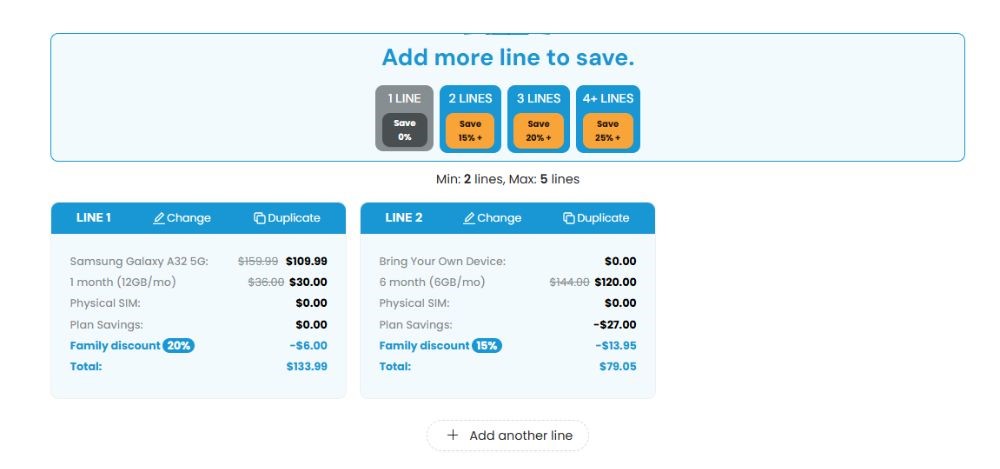
Introduction to Family Cell Plans
The Rising Need for Family Cell Plans
With the ever-growing dependency on mobile devices in every aspect of daily life, family cell plans have gained prominence. They’re not just a means to stay connected; these plans serve as a lifeline for coordinating family logistics, accessing education, and providing entertainment. As budgets tighten and communication becomes increasingly critical, families are on the lookout for plans that offer a blend of value and convenience. Family plans are important for several reasons:
- Cost Savings: Family plans offer discounts compared to individual plans.
- Convenience: One account for the family is more convenient than multiple individual ones.
- Shared Features: Family plans include shared calling, texting, and data.
- Pooling Resources: Shared data pools reduce overage risks and ensure sufficient data for all.
- Parental Controls: Many family plans offer monitoring and content blocking features.
- Emergency Communication: Ensures reliable communication during emergencies.
- Upgrade Options: Options for adding lines or upgrading devices at discounts.

Evaluating 2-Line Family Plans
Two-line family plans are commonly used by couples, small families, or households with two individuals who want to share a phone plan. These plans offer cost savings and convenience by bundling multiple lines under one account, typically with shared features like calling, texting, and data. They are popular among partners who want to share a plan, parents who want to provide phones for their children, or roommates who want to split the cost of a phone bill. Additionally, 2-line family plans are beneficial for those who want to take advantage of multi-line discounts offered by mobile carriers. When considering a 2-line family plan, one must weigh the balance between affordability and the variety of services offered. It’s key to ensure that the chosen plan aligns with both users’ needs while also fitting into the household budget. From shared data pools to individual stream allocations, the dynamics of how the plan operates are as important as the monthly fee. Remember to mull over both present requirements and potential future needs; a plan that grows with your family is typically a more prudent choice than one that might seem immediately cost-effective.
Decoding Family Cell Plan Features
Analyzing the Essentials: Data, Calls, and Texts
When dissecting the essentials of any family cell plan, data, calls, and texts are the backbone of the package. Data usage particularly takes center stage in this digital age, where streaming, browsing, and apps are integral to daily life. Check your past usage to estimate how much data you’ll realistically need. Unlimited talk and text are now common in most plans but scrutinize the fine print for any limitations. Data can either be shared between lines or allotted individually — the right model depends on each family member’s usage patterns. Also look into hotspot data allowance in your family bundle as this could be essential for some users.
International Features and Roaming for Globe-Trotting Families
For families with a penchant for travel, a plan’s international features are crucial. Some family plans offer generous international texting and data allowances, which can be a godsend when abroad. Look for options with flat roaming fees or daily caps to avoid bill shock after a vacation. If someone in your family frequently travels, ensure their line has the necessary support for seamless connectivity. Features might include international calling packages, data passes for short trips, and inclusive services in popular destinations. Some mobile phone plans will include free text, talk, and roaming in Mexico and Canada, but remember to check the fine print to avoid hidden charges.
Entertainment and Streaming Bonuses Included in Plans
The integration of entertainment and streaming perks in family cell plans can be a delightful bonus. With certain plans, you might unlock complimentary access to popular platforms such as Netflix, Hulu, or Disney bundles, offering substantial value and perhaps even offsetting separate subscription costs. These bonuses vary, so check if they match your family’s viewing preferences. Additionally, consider data usage: some providers offer data-free streaming, leaving your monthly data allowance untouched as you binge-watch your favorite shows.
Choosing the Best Cellular Plan With 2 Lines

Multi-Line Pricing
When selecting the best cellular plan for two lines, consider the multi-line prices offered by various providers. Look for plans that offer competitive rates, along with sufficient data, talk, and text allowances to meet your needs. Additionally, prioritize providers that offer additional perks like international calling, mobile hotspot usage, or family-friendly features such as parental controls. Be sure to compare the total cost, including any additional fees or charges, to determine the most cost-effective option for your usage patterns and budget.
Coverage and Network Quality Considerations
Coverage and network quality can make or break your satisfaction with a family cell plan. It’s wise to look into how well a network performs in your areas of frequent travel, as well as at home. Places with strong coverage will ensure that your family stays connected when it matters most. Investigate the latest network quality studies, like those from J.D. Power, which might rank carriers in the United States by region. Remember, 5G coverage is expanding, so even if you had issues in the past, it’s worth checking for improvements that might have been made since then.
Special Discounts and Offers for Families
Special discounts and offers can significantly reduce the monthly outlay for your family cell plan. Providers might extend promotions exclusively to families, such as a percentage off on additional lines or a two-line discount on senior plans. Military families and veterans are commonly recognized with special discounts. Also, it’s common to see seasonal holiday sales offering reduced rates or waived activation fees. Keep an eye on the deal sections of carrier websites and ask customer service representatives about current promos for families.
Many carriers offer device financing options as part of their family plans. With device financing, families can purchase the latest smartphones and pay for them in monthly installments over a set period, typically ranging from 12 to 36 months. This allows families to spread out the cost of expensive devices over time, making them more affordable and accessible. For example, AirVoice Wireless partners with Affirm to provide this service, enabling customers to enjoy flexible payment options when upgrading their devices.
Trade-in deals are a common feature offered by carriers alongside device financing in family plans. With trade-in deals, families can exchange their old smartphones for credits towards the purchase of new devices. Rogers often runs trade-in promotions where customers can receive trade-in credits based on factors like the age, condition, and model of the device being traded in. These credits can then be applied towards the cost of upgrading to new smartphones.
Budget-Friendly Guide for Smaller Families
Coverage and network quality can make or break your satisfaction with a family cell plan. It’s wise to look into how well a network performs in your areas of frequent travel, as well as at home. Places with strong coverage will ensure that your family stays connected when it matters most. Investigate the latest network quality studies, like those from J.D. Power, which might rank carriers in the United States by region. Remember, 5G coverage is expanding, so even if you had issues in the past, it’s worth checking for improvements that might have been made since then.
Special Discounts and Offers for Families
Special discounts and offers can significantly reduce the monthly outlay for your family cell plan. Providers might extend promotions exclusively to families, such as a percentage off on additional lines or a two-line discount on senior plans. Military families and veterans are commonly recognized with special discounts. Also, it’s common to see seasonal holiday sales offering reduced rates or waived activation fees. Keep an eye on the deal sections of carrier websites and ask customer service representatives about current promos for families.
Many carriers offer device financing options as part of their family plans. With device financing, families can purchase the latest smartphones and pay for them in monthly installments over a set period, typically ranging from 12 to 36 months. This allows families to spread out the cost of expensive devices over time, making them more affordable and accessible. For example, AirVoice Wireless partners with Affirm to provide this service, enabling customers to enjoy flexible payment options when upgrading their devices.
Trade-in deals are a common feature offered by carriers alongside device financing in family plans. With trade-in deals, families can exchange their old smartphones for credits towards the purchase of new devices. Rogers often runs trade-in promotions where customers can receive trade-in credits based on factors like the age, condition, and model of the device being traded in. These credits can then be applied towards the cost of upgrading to new smartphones.
Best Mobile Networks with 2 Lines – Prices and Perks
Looking for a family phone plan in the USA that fits your needs and budget? Several providers offer competitive options tailored for two lines, catering to various preferences and usage requirements. From budget-friendly choices like Mint Mobile and US Mobile to larger carriers such as T-Mobile and Verizon, there’s a range of plans starting at different price points. Whether you prioritize affordability, network coverage, or additional perks, understanding these options can help you make an informed decision for staying connected with your loved ones. Let’s explore what each provider offers in their two-line family phone plans. See the table below highlighting the top mobile networks along with their average pricing and additional perks:
|
Provider |
Plan Details |
Additional Perks |
|
Mint Mobile |
Flexible plan starting at $30/month for both lines |
Unlimited talk & text |
|
T-Mobile |
Plans starting at $80/month for two lines |
Netflix subscription |
|
Verizon |
Plans starting at $70/month for two lines |
Disney+ subscription, Apple Music trial |
|
AT&T |
Plans starting at $60/month for two lines |
HBO Max subscription |
|
AirVoice Wireless |
Plans starting at $18.00/month per line for new customers on a 3-month plan |
Customizable plans, Unlimited international calling to over 80+ countries |
Prepaid vs. Postpaid: Which Is Best for 2 Lines?
Choosing between prepaid and postpaid plans for 2 lines boils down to your family’s lifestyle and financial preference. Prepaid plans typically come with a lower cost and no credit check requirement, ideal for those who want to manage their expenses tightly. Postpaid plans, on the other hand, offer additional perks and the convenience of getting billed after usage, which can be attractive for families wanting extra features or higher data prioritization. Evaluate your family’s usage habits and budget to decide which type best suits your needs.

How No-Contract Plans Can Keep Costs Down
No-contract plans are a fantastic way to keep a tight rein on your phone bill without being tethered to a long-term commitment. No-contract plans, such as those offered by MVNOs like AirVoice Wireless, provide a budget-friendly and flexible alternative to traditional contract plans, offering several advantages for cost-conscious consumers. Without long-term commitments, customers have the freedom to switch plans or providers without facing early termination fees, resulting in lower monthly costs and greater flexibility. Additionally, these plans often offer transparent pricing with no hidden fees, making it easier to budget effectively. With options to adjust plans based on usage and pay-as-you-go features, users can tailor their plans to fit their needs and avoid overpaying for services they don’t use. No-contract plans also typically do not require credit checks, ensuring accessibility to a wider range of individuals. Overall, the ability to bring your own device, combined with transparent pricing and flexibility, makes no-contract plans an appealing choice for those looking to keep costs down without sacrificing quality or convenience.

Smart Tips to Cut Down Your Phone Bill
Trimming your phone bill can be easier than you think with a few smart strategies. Start by scrutinizing your current usage and eliminate any superfluous features or services. Take advantage of autopay and paperless billing discounts often provided by carriers. Consider buying your phones outright instead of financing them through your carrier, as this can lead to savings over time. Lastly, keep an eye out for special promotions or ask your provider about any applicable family discounts. These little tweaks can add up to significant budget relief.
- Bringing your own device (BYOD) is a popular option offered by carriers in family plans, allowing families to use their existing smartphones instead of purchasing new ones. Bringing your own device offers a host of benefits worth considering. BYOD allows you to leverage your existing smartphones, saving you the expense of purchasing new devices and potentially lowering your monthly costs. With BYOD, you retain the familiarity of your current devices, along with your personalized settings and data. This seamless transition to a family plan ensures that you can enjoy the benefits of shared data, unlimited talk and text, and additional features, all while maintaining the devices you know and love.
- Monitoring your family’s data usage is vital to avoid overages in your next billing cycle. Begin by reviewing past bills and checking phone settings to gauge individual usage patterns. Take into account the activities each family member engages in, such as streaming, social media, and gaming, as these impact data consumption differently. Utilize online calculators to estimate the total data needs based on these activities and the number of users. It’s essential to plan for potential growth or changes in usage patterns to avoid unexpected charges or limitations. By following these steps, you can ensure that the chosen plan aligns with your family’s data needs and allotment without paying for excess data.
The Real Takeaway on Unlimited Data for Two
Unlimited” in the context of phone plans typically refers to unlimited usage of certain features like calling, texting, and data within specified limits or under certain conditions. However, it’s crucial to understand that there are often nuances and limitations to what “unlimited” truly means:
- Unlimited Data: Many phone plans advertise “unlimited data,” but there’s usually a catch. While you may have access to unlimited data, there’s often a threshold after which your speeds may be throttled during times of network congestion. This means that while you can continue using data, your speeds might slow down, affecting your browsing, streaming, and other online activities.
- Unlimited Calling and Texting: Unlimited calling and texting typically refer to domestic usage within the country where the plan is purchased. International calling and texting may not always be included in the unlimited package and might incur additional charges or have limitations.
Navigating the ‘unlimited’ waters requires understanding that not all unlimited plans are created equal. For you and your family, ‘unlimited’ should mean no overage charges for data use but watch out for the asterisk. Take this knowledge when reviewing the terms and conditions to understand the true extent of the services provided and any potential limitations or conditions attached.
- Deprioritization: In congested areas or during times of network congestion, users on unlimited plans may experience slower speeds compared to those on tiered plans. This is because network operators may prioritize users who haven’t reached their data threshold.
- Additional Fees: While the base plan may offer unlimited features, there could be additional fees for premium services or add-ons. For example, international calling, roaming, or accessing certain premium content might incur extra charges.
- Throttling: Even within the realm of “unlimited” plans, there may be restrictions on specific activities. For instance, some providers may throttle video streaming quality or limit the amount of high-speed tethering data available.
- Fine Print: Always read the fine print. Some providers may impose restrictions on certain activities like tethering (using your phone as a mobile hotspot), streaming quality, or using your phone abroad. These limitations are usually outlined in the terms and conditions of your plan.
FAQs
What is the average cost of a cell phone plan for 2 lines?
The average cost of a cell phone plan for 2 lines can range significantly depending on the carrier and the services included, from about $30 to $120 per month. This variation accounts for factors like data limits, network quality, international features, and additional perks. With a single-line plan averaging around $76 per month, a multiline plan often represents savings, especially when promotional discounts are applied.
Can I combine different phone lines with different needs under one family plan?
Absolutely, many family plans are designed to accommodate the unique needs of each family member. Most carriers offer the flexibility to mix and match plans, so you can combine different types of phone lines on the same account. One line could have unlimited data while another has just a basic talk and text plan, ensuring each family member has what they need without paying for unnecessary extras. Take this example of AirVoice Wireless’ 2-line plan: Line 1 purchased a new Samsung Galaxy A32 5G with a 1-month 12GB plan, while the other line opted for the BYOD with a 6-month 6GB plan. This kind of flexibility allows users to enjoy the freedom MVNOs provide.

What features should I consider most for a family cell plan with 2 lines?
When considering a family cell plan for 2 lines, focus on the data package to ensure it meets your usage patterns. Unlimited talk and text are standard, but data is where needs can vary significantly. Additional considerations include network reliability, speed, and coverage. Look for plans with shared or dedicated data options, parental controls for safety, and potential perks that align with your family’s lifestyle, such as streaming service subscriptions or international features for traveling.
Are there any hidden costs in family cell plans that I should be aware of?
Yes, family cell plans may come with hidden costs that can creep up on your monthly bill. These could include taxes, regulatory fees, equipment installment plans, and even administrative fees that aren’t always prominent in advertised prices. Additionally, if you exceed data caps on non-unlimited plans, overage charges can be exorbitant. To avoid surprises, read the fine print carefully, ask your provider detailed questions, and consider taxes and fees when calculating the total monthly cost.




Leave A Comment